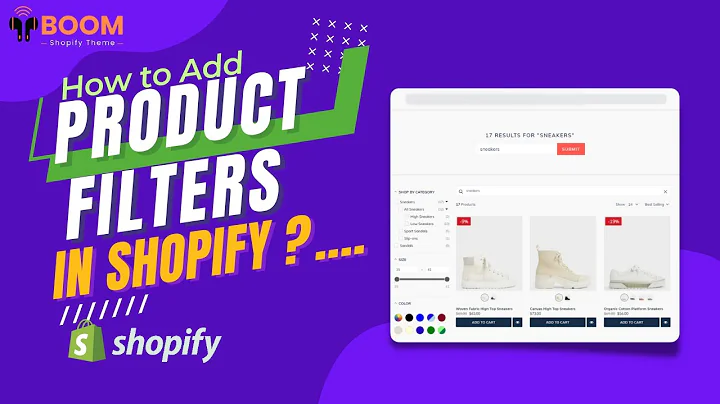Boost Your Shopify Conversion Rate with These Best Practices
Table of Contents:
- Introduction
- Understanding Conversion Rate
- Factors Affecting Conversion Rate
3.1 Product Category
3.2 Advertising Channels
3.3 Website Design and Colors
- Best Practices to Maximize Conversion Rate
4.1 Importance of Colors
4.2 Utilizing Subdomains
4.3 Top of Page Message
4.4 Product Titles and Descriptions
4.5 Website Speed
4.6 Professional Product Images
4.7 Avoiding Pop-ups
4.8 Incorporating Reviews
- Conclusion
How to Increase Your Shopify Conversion Rate: Best Practices for Success
In today's competitive e-commerce landscape, having a high conversion rate is crucial for the success of your Shopify store. But what exactly is a good conversion rate? And how can you improve it? In this article, we will explore the factors that affect conversion rates and provide you with the best practices to maximize your store's conversion rate.
Understanding Conversion Rate:
Before delving into the strategies to boost your conversion rate, it is essential to understand what this metric signifies. Conversion rate refers to the percentage of website visitors who complete a desired action, such as making a purchase or signing up for a newsletter. A conversion rate of above 3% is considered excellent and places you among the top 20% of all Shopify stores.
Factors Affecting Conversion Rate:
Various factors influence your conversion rate, including product category, advertising channels, and website design.
-
Product Category:
Different product categories have varying conversion rates due to customer preferences and purchase behavior. For example, clothing and beauty products tend to have higher conversion rates compared to baby and child products, as customers may be more cautious when buying for their children.
-
Advertising Channels:
The choice of advertising channels can significantly impact your conversion rate. Ads on platforms like TikTok may not yield as high of a conversion rate as those on Google search engine, where customers are actively searching for products to purchase.
-
Website Design and Colors:
The colors and overall design of your website play a crucial role in shaping customer perceptions and influencing their decision-making. Colors, especially blue, can evoke trust and security, making them ideal for building customer confidence. Implementing a complementary color scheme that matches your brand and evokes positive emotions can enhance your conversion rate.
Best Practices to Maximize Conversion Rate:
Now that we have explored the factors affecting conversion rates, let's delve into the best practices you should implement in your Shopify store to optimize your conversion rate.
-
Importance of Colors:
Consider using color psychology to your advantage. Research colors that evoke trust and apply them strategically in your website design. Focus on creating a visually appealing and cohesive color scheme that resonates with your target audience.
-
Utilizing Subdomains:
Subdomains allow you to enhance your localization efforts and build trust with customers in specific markets. By creating subdomains for different regions, such as us.yourdomain.com or uk.yourdomain.com, you create a customized experience that appeals to customers in those markets and boosts your conversion rate.
-
Top of Page Message:
Utilize the top section of your website to convey compelling messages, such as free shipping, limited-time offers, or exclusive discounts. This grabs the attention of visitors and entices them to explore further, increasing the likelihood of conversions.
-
Product Titles and Descriptions:
Craft compelling and descriptive titles and product descriptions that highlight the unique selling points and benefits of your products. Instead of solely focusing on persuading customers to buy from you, emphasize why your product is the best in its category.
-
Website Speed:
Ensure that your Shopify store loads quickly to prevent visitors from leaving due to slow loading times. Optimize your website's performance by compressing images and minimizing the use of unnecessary scripts or plugins.
-
Professional Product Images:
Avoid using generic product images from AliExpress or other similar platforms. Invest in high-quality, professional product images that showcase your products in the best possible light. This enhances the overall appeal and credibility of your store, increasing the likelihood of conversions.
-
Avoiding Pop-ups:
Refrain from implementing intrusive pop-ups that disrupt the user experience. While pop-ups can be effective for capturing leads or promoting offers, they can also negatively impact conversion rates if they annoy or distract visitors.
-
Incorporating Reviews:
Include genuine customer reviews with user pictures to build trust and authenticity. Encourage customers to share their experiences and provide detailed feedback. When potential customers see positive reviews based on real experiences, they are more likely to trust your products and make a purchase.
Conclusion:
Boosting your Shopify conversion rate requires a holistic approach that incorporates various elements. By implementing the best practices mentioned in this article, you can enhance your website's appeal, build trust with customers, and ultimately increase your conversion rate. Remember, conversion rate optimization is an ongoing process, so continuously monitor and iterate your strategies to achieve long-term success.
Highlights:
- Understand what conversion rate is and its significance in e-commerce.
- Factors affecting conversion rate include product category, advertising channels, and website design.
- Implementing the right colors, utilizing subdomains, and utilizing top-of-page messages can positively impact conversion rates.
- Compelling product titles, professional images, fast website speed, and genuine customer reviews are crucial for success.
- Continuous optimization and monitoring are essential for long-term conversion rate improvements.
FAQ:
Q: How can I improve my Shopify conversion rate?
A: There are several strategies to enhance your conversion rate, including optimizing website design, utilizing appealing colors, implementing top-of-page messages, creating professional product images, and incorporating genuine customer reviews.
Q: What is a good conversion rate for a Shopify store?
A: A conversion rate of above 3% is considered excellent and places your store among the top 20% of all Shopify stores.
Q: How does the product category affect the conversion rate?
A: Different product categories have varying conversion rates. Factors such as customer preferences and purchase behavior influence the conversion rate of specific product categories.
Q: What role do advertising channels play in conversion rate optimization?
A: The choice of advertising channels can significantly impact conversion rates. Different platforms, such as TikTok or Google search engine, yield varying conversion rates due to differences in user behavior and intent.
Q: Why are professional product images important for conversion rate optimization?
A: Professional product images enhance the overall appeal and credibility of your store, leading to higher conversion rates. They showcase your products in the best possible light, increasing customer trust and willingness to make a purchase.






















